EU Drugs Action Plan for 2009-2012
Drug Abuse
20.12.2008 EN Official Journal of the European Union C 326/7
IV
(Notices)
NOTICES FROM EUROPEAN UNION INSTITUTIONS AND BODIES
COUNCIL
EU Drugs Action Plan for 2009-2012
(2008/C 326/09)
Introduction
Illicit drugs are a major concern for the citizens of Europe, a major threat to the security and health of European society and a threat to living conditions worldwide.
In December 2004, the European Council unanimously endorsed the EU Drugs Strategy for 2005-2012 (1), which aims to achieve a high level of protection, well-being and social cohesion by preventing and reducing drug use.
The adoption of the Strategy in itself gave a clear signal that political concern about drugs across the European Union transcends the differences in approach that exist among Member States. The Strategy, implemented by two successive EU Drugs Action Plans, confirmed that all Member States subscribe to the same set of basic principles: that there should be a balanced approach to reducing the supply and demand for drugs, which is based first and foremost on the fundamental principles of EU law and, in every regard, upholds the founding values of the Union: respect for human dignity, liberty, democracy, equality, solidarity, the rule of law and human rights. The Strategy and its Action Plans aim to protect and improve the well-being of society and of the individual, to protect public health, to offer a high level of security for the general public. This should be accompanied by horizontal measures in which drug policy is based on reliable data regarding the nature and extent of the problem, on —— increasingly — cross-border — coordination and on cooperation with and towards third countries and international organisations. The Strategy and its Action Plans are also based on the relevant UN Conventions, which are major legal instruments for addressing the world drug problem.
The Drugs Strategy also provides the framework for two consecutive four-year Action Plans. The first Action Plan (2005-2008) (2) set out over 80 actions to help coordinate major areas of government intervention in the field of illegal drugs, covering public health, law enforcement, customs, criminal justice and external relations. While implementation is often the responsibility of the Member States, the Commission plays an active part in facilitating and evaluating the work in progress, in addition to monitoring anti-drug legislation, such as Council Framework Decision 2004/757/JHA on Illicit Drug Trafficking, on which it will report in mid 2009. Moreover, guided by the lessons learnt over the past four years, the Commission is now proposing a second Action Plan (2009-2012) to be endorsed by the Council.
What has the present Action Plan on Drugs achieved so far?
The current Plan states as its ultimate aim to:
.. significantly reduce the prevalence of drug use among the population and to reduce the social and health damage caused by the use of and trade in illicit drugs,.
(1) 15074/04 CORDROGUE 77 SAN 187 ENFOPOL 187 RELEX 564.
(2) OJ C 168, 8.7.2005, p.1.
The evaluation report (1) is a joint effort by the Commission, the Member States, the European Monitoring Centre on Drugs and Drug Addiction (EMCDDA), Europol, and European NGO networks represented in the Civil Society Forum. It is the most extensive assessment of the implementation of EU drug policy to date and shows that the objectives of the present Plan have been partly achieved:
— — drug use in the EU remains at high levels. Available data suggest that the use of heroin, cannabis and synthetic drugs has stabilised or is declining but that cocaine use is rising in a number of Member States. The total number of people in the EU who have at some time taken drugs (lifetime prevalence) — — is estimated at 70 million for cannabis, at least 12 million for cocaine, 9,5 million for ecstasy, and 11 million for amphetamines, while at least half a million people are known to be receiving substitution treatment for drugs like heroin (2),
— — although there is no reason for complacency, data available for comparable countries in other parts of the world show that the consumption of cannabis, cocaine, and amphetamines in the EU is significantly lower than, for instance, in the US. The same is true for the number of reported HIV infections related to drug injections,
— — the evaluation also shows that Member States' drug policies are converging and that there is a shift towards underpinning national policies with action plans,
— — evidence so far shows that the EU is succeeding in at least containing the complex social phenomenon of widespread substance use and abuse in the population, and that it is increasingly focusing on measures to address the harm caused by drugs to individuals and society. It is important to note that it has done so in spite of the fact that over the period under review the world's illicit opiate production rose sharply and an unprecedented traffic of cocaine has been targeted at the EU. Seen against this background of sharply increased supply, the EU's record of managing the problem emerges in a more positive light,
— — in terms of international cooperation, there is now better coordination of EU positions in international fora on drugs, as in the UN's Commission on Narcotic Drugs (CND) for instance. Moreover, the EU's integrated and balanced approach to drugs is increasingly serving as a model for other countries worldwide.
The current Action Plan (2005-2008) is an ambitious exercise. While progress has been made in many areas, weaknesses have also been identified.
Policy coordination problems persist in many areas, and even if the quality of information on the EU situation regarding drug use, prevention and treatment has consistently improved, considerable knowledge gaps remain: there is a persistent lack of reliable data on drug supply but also on the scope and outcomes of drug-related assistance to third countries.
How to increase commitment across society to reduce drug use
Clearly the EU needs to do more to reduce the impact of health, social, developmental, and economic problems caused by drug use. If millions of Europeans have at some stage taken drugs or are doing so right now, there is a gap between public policy and public behaviour that no society can afford to ignore.
There is evidence to suggest that one of the more (cost-) effective approaches to deal with drug use is for public services engaged in prevention, treatment, harm reduction and law enforcement, to work together in partnership with voluntary organisations and service providers. In other words, an alliance between citizens and the institutions created by them and for them.
It is time to put the people of Europe at the centre of policy in this field and to get Europe's citizens more involved. As a first step, the Commission helped set up the European Civil Society Forum on Drugs, in 2006. To support the implementation of the EU Action Plan on Drugs, the Commission will, during the life of the next Action Plan, examine ways to mobilise all those who wish to take part for a formal commitment to do what is necessary at their level and with the means at their disposal to reduce the harm that drugs do to people. An idea to develop in this respect is the formulation of a ‘European Alliance on Drugs’, which aims to mobilise a broad range of civil society structures that are active both within and outside the drug field.
(1) Commission Staff Working Paper — Report of the Final evaluation of the EU Drugs Action Plan (2005-2008) (doc.13407/08 ADD 3).
(2) EMCDDA Annual Report 2007.
Towards a new Action Plan on Drugs 2009-2012
The EU Drugs Strategy deals with a complex phenomenon that requires a long-term approach to bring about change. It is centred on the two key dimensions of drug policy, drug demand reduction and drug supply reduction, complemented by three cross-cutting themes, coordination, international cooperation and information, research and evaluation.
To support the Strategy, the Commission proposes a new Action Plan on Drugs (2009-2012), which builds on the existing framework but also on the lessons learned over the past four years. With due regard to national legislation, it identifies the following priorities:
1. Improving coordination, cooperation and raising public awareness
Coordination and cooperation in the drug field can be strengthened at both European and national level so that drug policies are relevant to professionals and civil society, while at the same time enabling these structures to provide feedback to inform policy.
2. Reducing the demand for drugs
We need to further improve the effectiveness of measures to reduce drug use and its consequences by improving the coverage, quality and effectiveness of demand reduction interventions, i.e. prevention, treatment and harm reduction services. This includes particular attention for vulnerable groups and the prevention of poly-drug use (combined use of illicit and licit substances, including alcohol, volatile substances and tobacco).
3. Reducing the supply of drugs
We need more effective law enforcement at EU level to counter drug production and trafficking, making full use of the capacities of Europol and other EU structures. Actions should be based on an intelligence-led approach that systematically prioritises the suppliers causing the most harm or posing the most serious threat. The work currently being undertaken to strengthen the links and coherence between the data used by the various EU JHA entities will be necessary to support this. More coordinated operations via regional security platforms should be supported. The new platforms should be set up without overlapping and be compatible with existing structures.
4. Improving international cooperation
The effectiveness of EU, the world's major donor in the struggle for sustainable solutions to the global drug problem, would benefit greatly from better coordination of national and Community policies. We are ready to intensify our commitment in the field of international cooperation to this end, while reaffirming that effective drug control must be based on the concept of a ‘balanced approach' — emphasizing that illicit drug cultivation is an important component of drug supply.
5. Improving understanding of the problem
We need to increase our knowledge of all aspects of drug use through more and better coordinated research and data, including data on drug-related crime and on the way the illicit drug supply market works.
The Action Plan that follows is intended as a framework to implement these priorities and to add European value where appropriate.

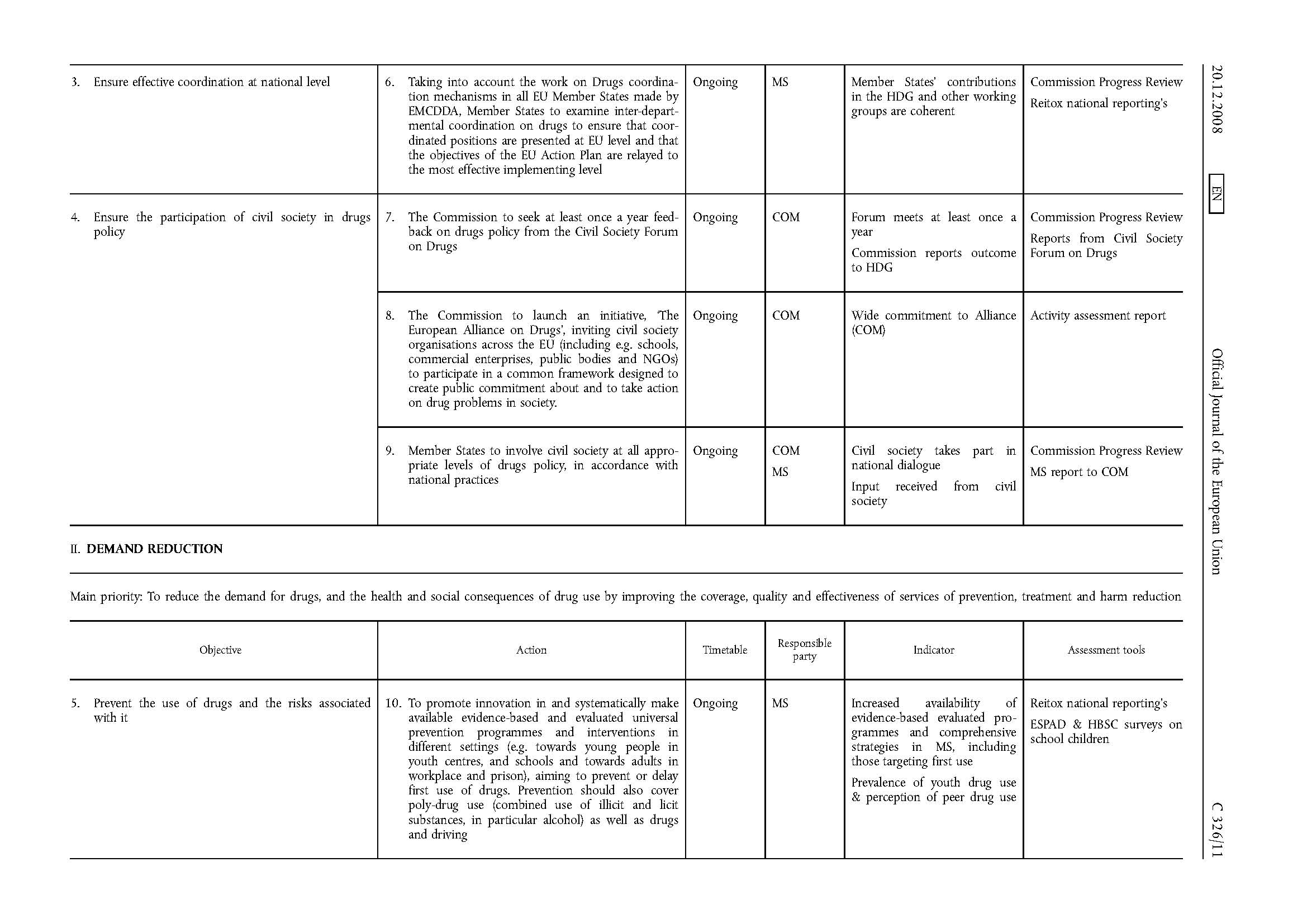
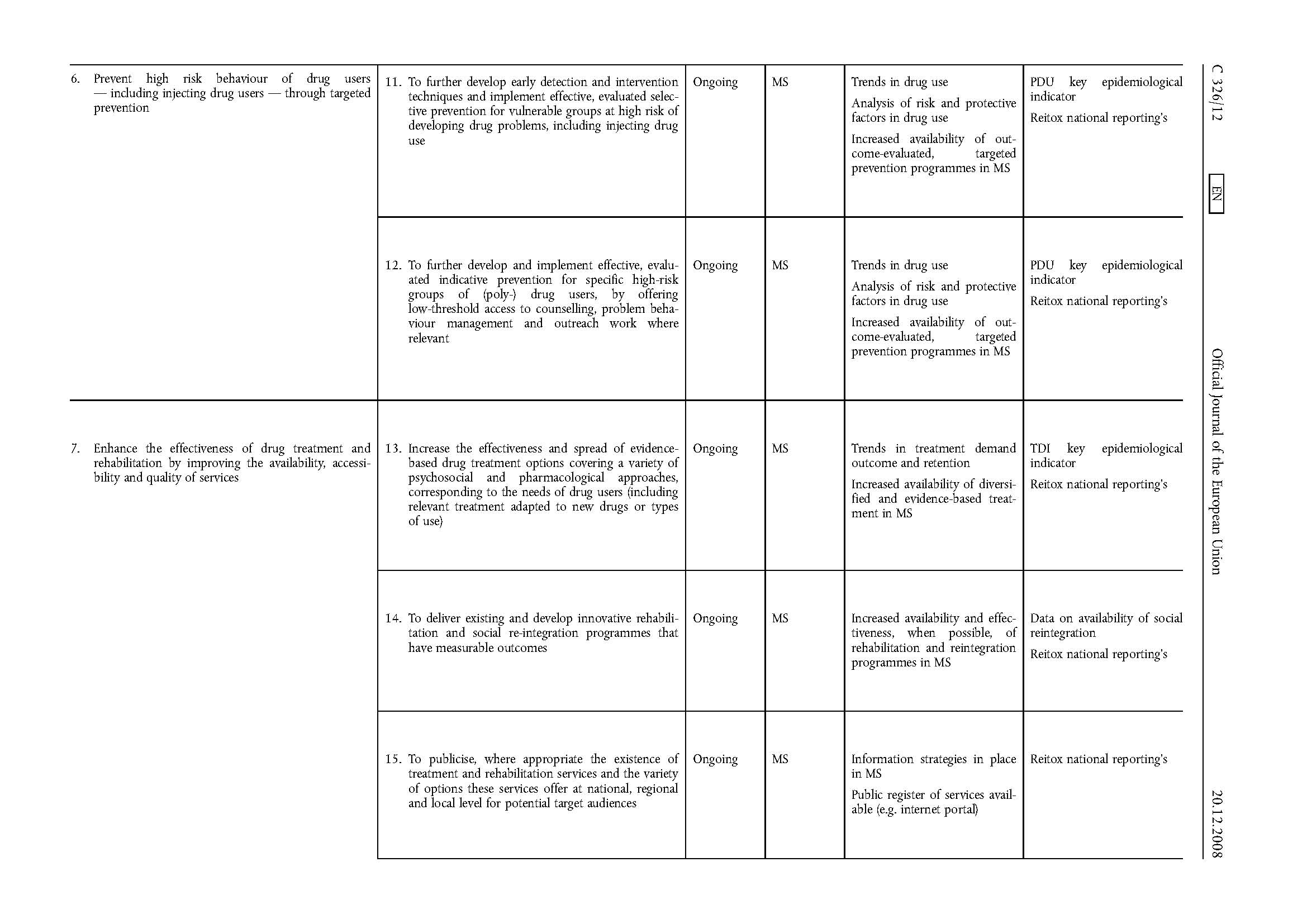
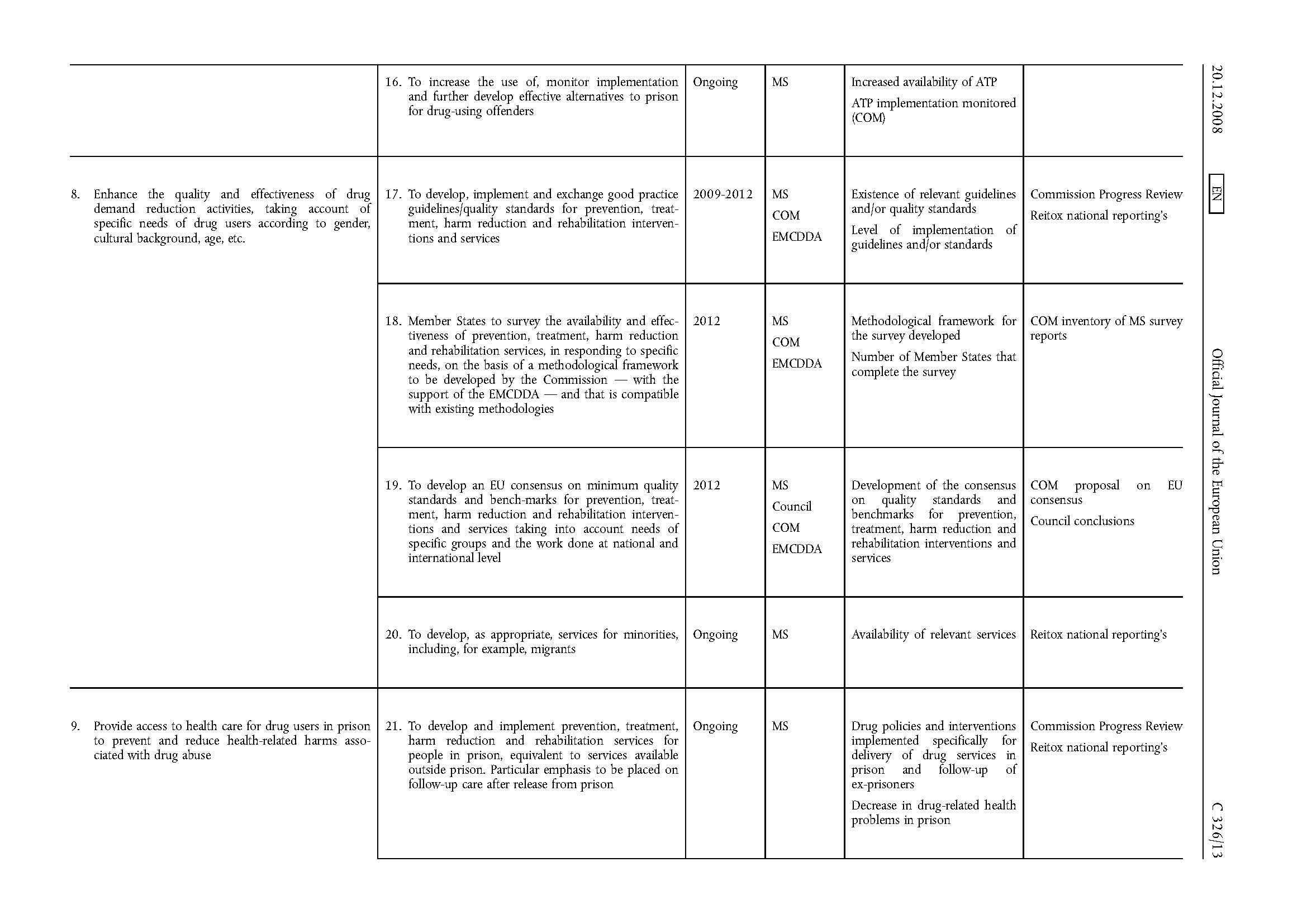


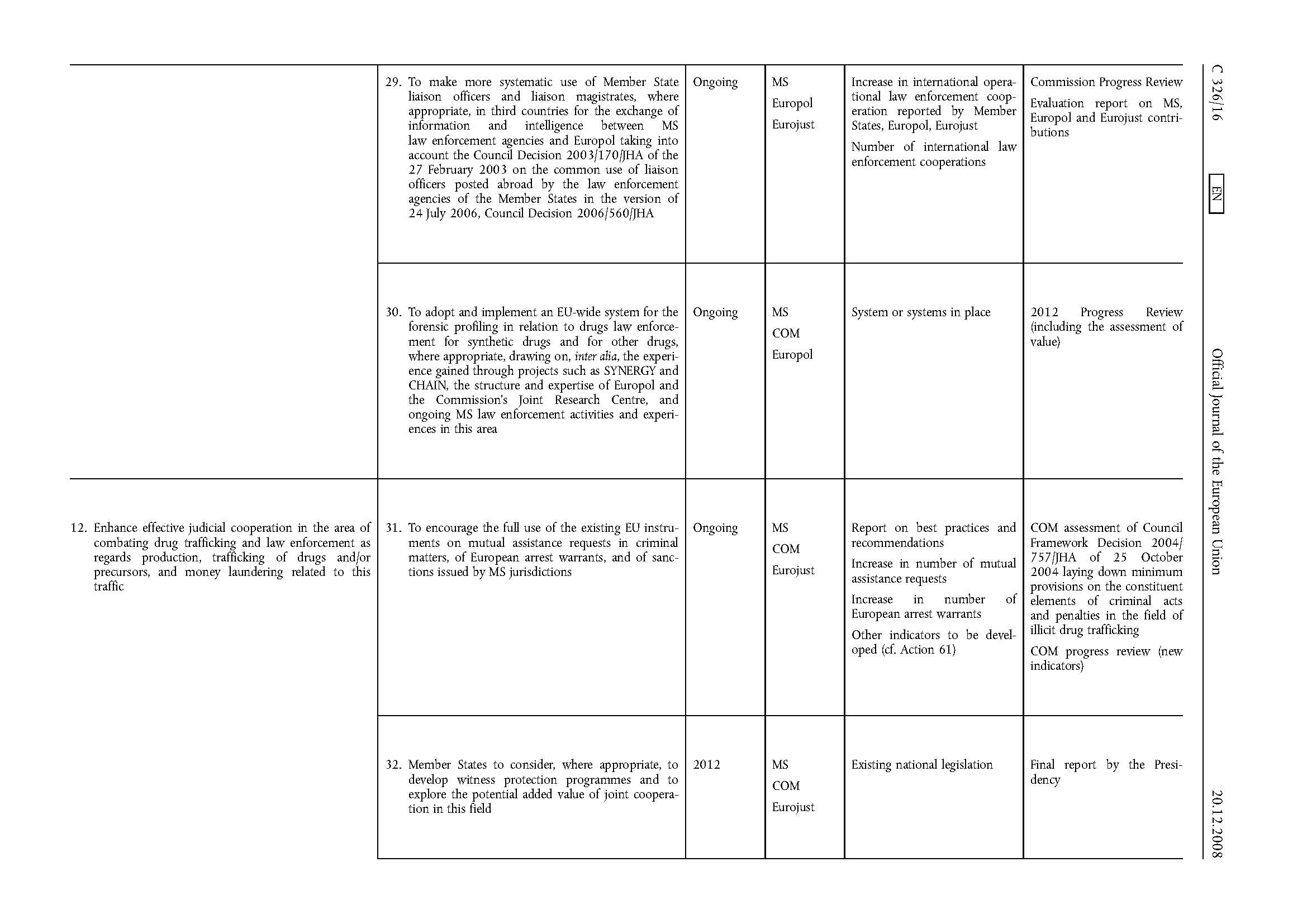

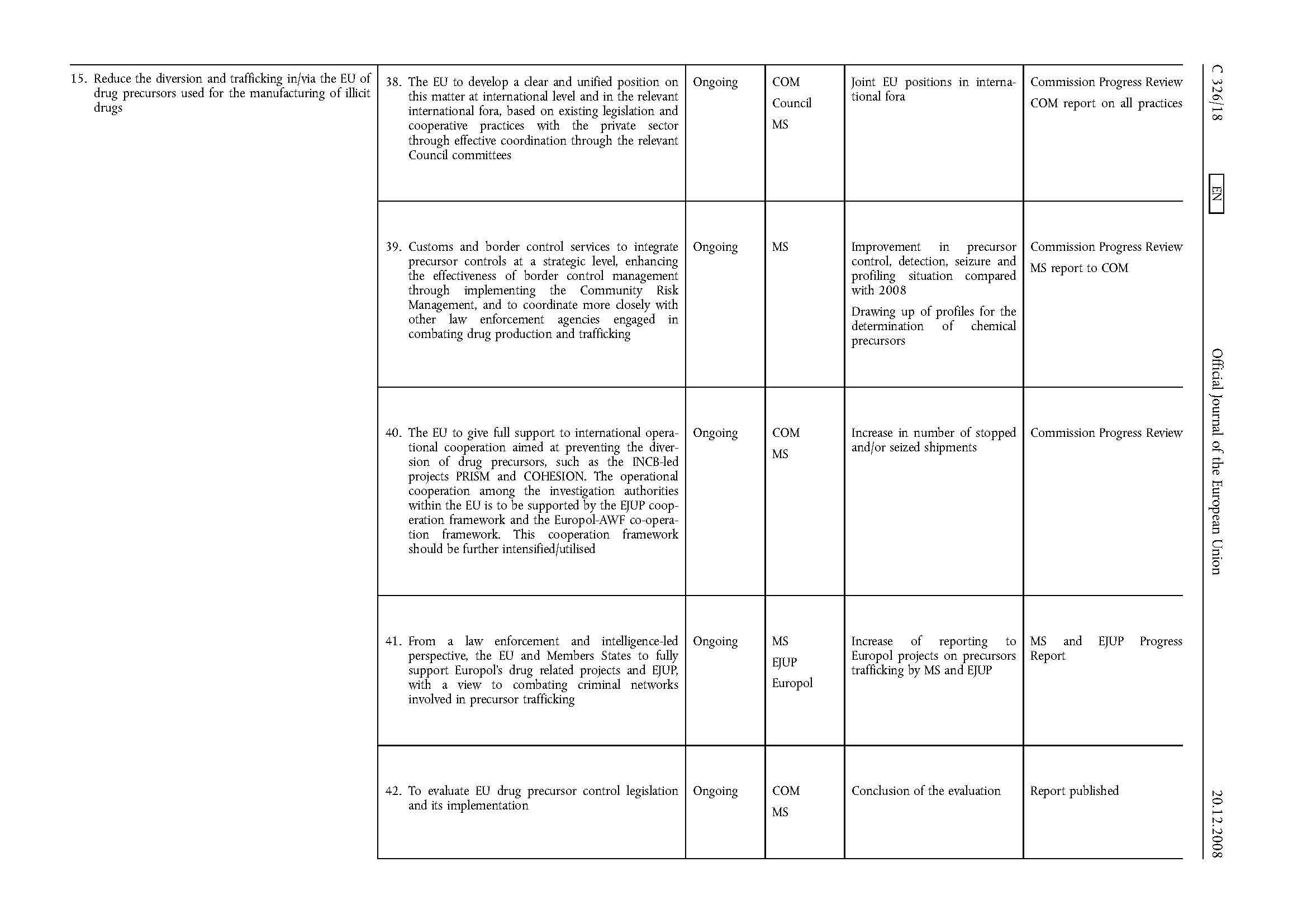
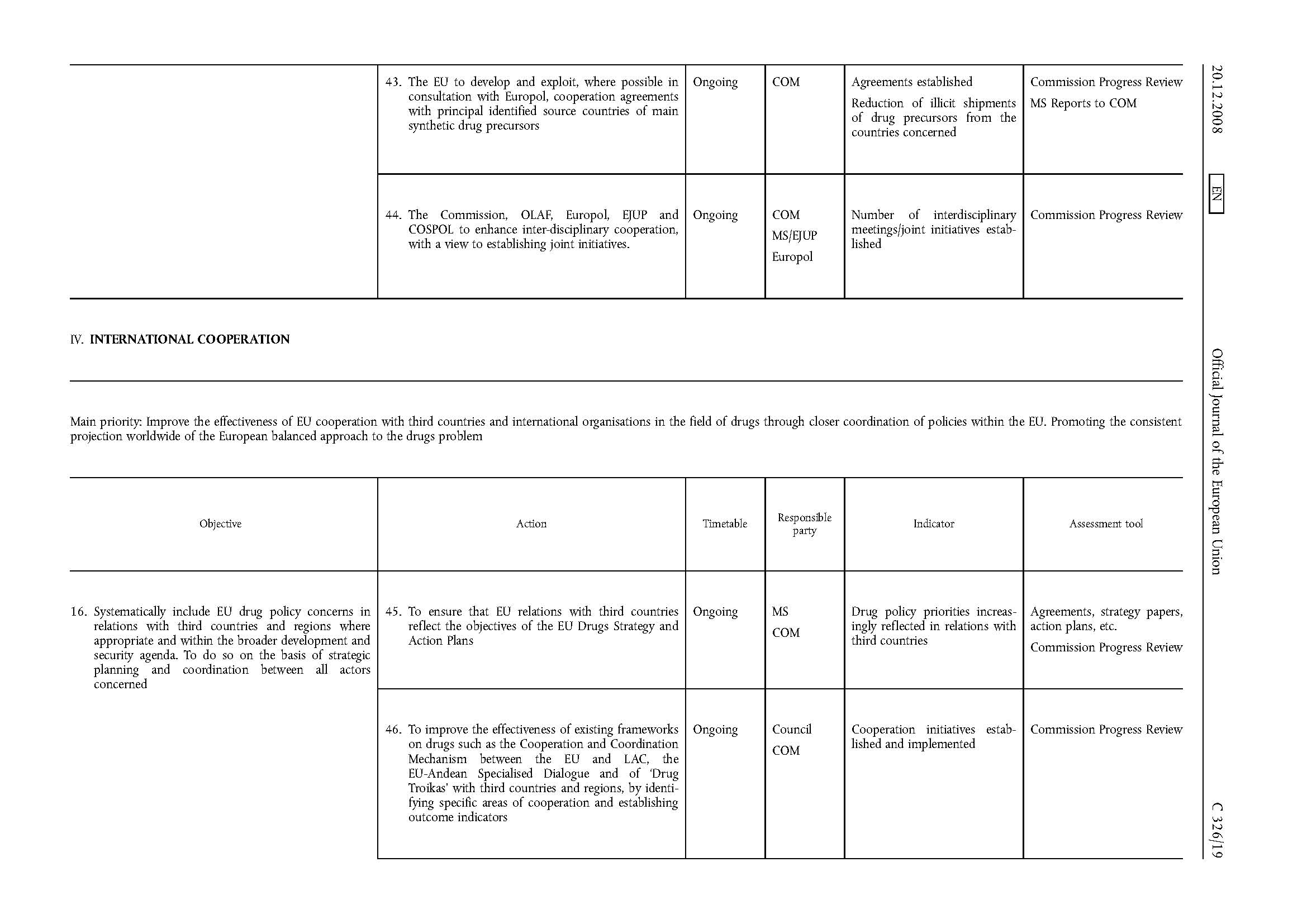

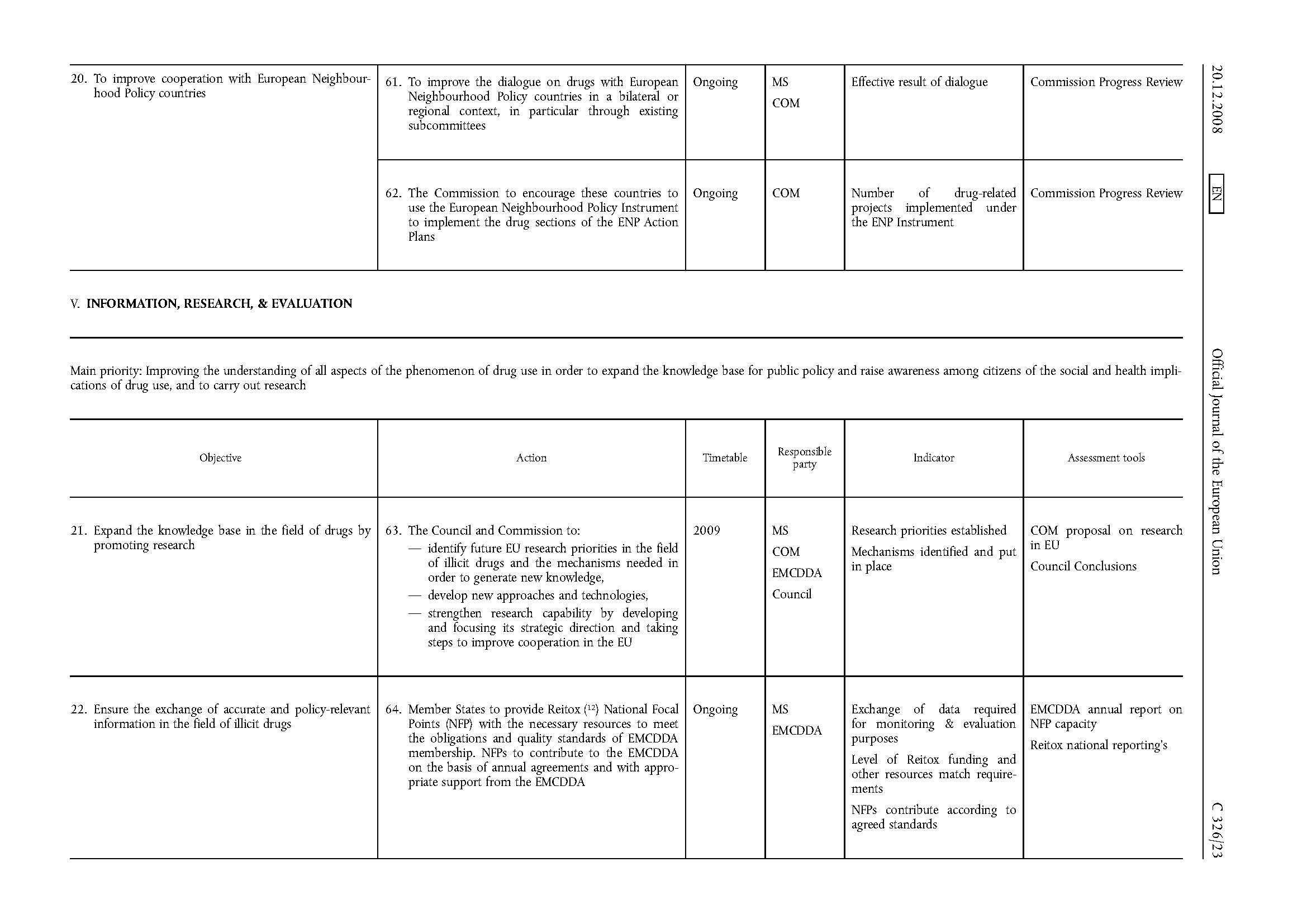
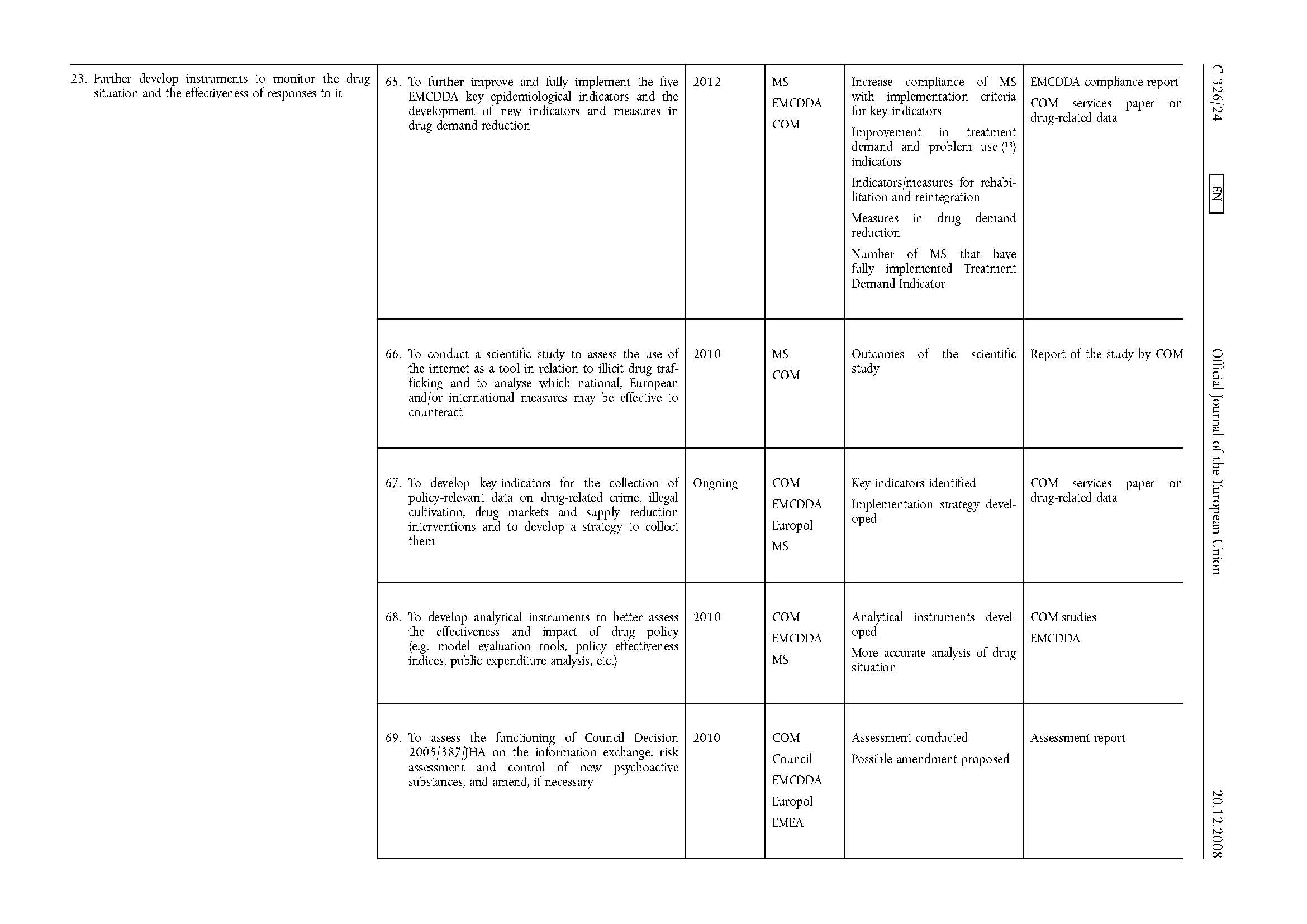

(1) These Council Working Parties include: Police and Customs Working Parties, the Multidisciplinary Group on Organised Crime, the Health Working Group, External Affairs Working Groups and the Economic Issues Working Group.
(2) This action builds on the Council Recommendation 2003/488/EC on the prevention and reduction of health-related harm associated with drug dependence.
(3) European Police College; Council Decision 2005/681/JHA.
(4) Including dismantling of illicit drug laboratories.
(5) Project SYNERGY includes the Analysis Work File (AWF), the Europol Illicit Laboratory Comparison System (EILCS) and the Ecstasy Logo System, the latter incorporated within the general Europol Synthetic Drugs Seizure System (ESDSS).
(6) 12353/02 CORDROGUE 78 CODRO 1 NIS 107.
(7) 7163/1/99 REV 1 CORDROGUE 19 CODRO 2; Port of Spain Declaration — 10451/07 CORDROGUE 34 COLAT 9 AMLAT 54.
(8) 5062/2/03 REV 2 CORDROGUE 3 COWEB 76 + COR 1.
(9) 13501/1/08 REV 1 CORDROGUE 71 UD 172, Annex III.
(10) Political Declaration (resolution S-20/2, Annex) of the twentieth Special Session of the United Nations General Assembly.
(11) 5062/2/03 REV 2 CORDROGUE 3 COWEB 76 + COR 1.
(12) Réseau Européen d'Information sur les Drogues et les Toxicomanies.
(13) EMCDDA indicator to be brought in line with criteria of public health relevance (such as intensity of use and health consequences) including international classifications (DSM-V/ICD-10).
20.12.2008 EN Official Journal of the European Union C 326/25
Last Updated (Wednesday, 13 January 2010 17:19)












